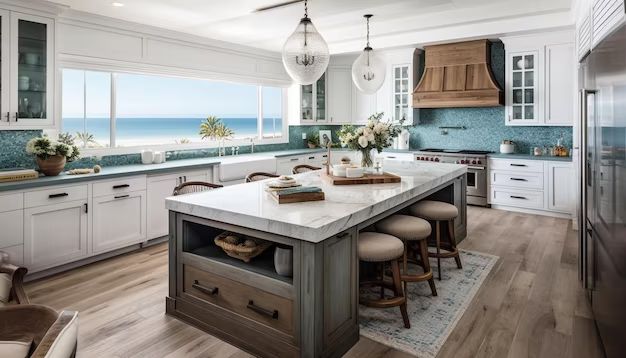Two tier islands have been a popular kitchen design feature for many years. They provide extra prep and dining space while separating the kitchen from the living areas. However, some wonder if two tier islands are becoming outdated as kitchen trends shift. Here we’ll look at the pros and cons of two tier islands and whether they still have a place in contemporary kitchens.
Page Contents
What are two tier islands?
A two tier island has two levels – one for seating and dining, the other for food preparation and cooking. The lower level provides a surface for chopping, kneading and other tasks. The higher level serves as a breakfast bar or casual dining spot. There’s often an overhang above the lower tier to provide separation.
Two tier islands create multiple work zones and purposes within the overall kitchen footprint. They allow for meal prep and cleanup on one level while providing seating and eating space on the other. This helps maximize efficiency and functionality.
What are the benefits of a two tier island?
There are several advantages to choosing a two tier island design:
Extra prep space
The lower tier provides significant additional counter space for food preparation tasks like rolling dough, dicing vegetables, arranging charcuterie boards and more. For avid home cooks, this extra surface area can be extremely beneficial, especially in smaller kitchens.
Defined work zones
Having two distinct levels helps delineate spaces for prepping and for dining. It creates separation between messy cooking tasks and where people congregate to eat and socialize. This can help reduce clutter on the dining space.
Casual dining spot
The raised bar or countertop allows for casual meals and snacks. Family members and guests can sit around the higher tier to quickly grab a bite close to the cooking area. No need to bring food over to the dining table for informal eating.
Open floor plan flow
A two tier island can help define the kitchen within an open concept living space. The lower counter anchors the cooking zone while the higher tier signals the transition into the dining area. This can improve flow and functionality.
Visual interest
The varied counter heights create appealing dimension and architectural details. This breaks up the uniformity of a single level island. It can also add opportunities for decorative legs, corbels or other embellishments.
What are the downsides?
Though two tier islands have many perks, there are a few potential drawbacks:
Wasted space
Depending on the exact heights used, there may be wasted space underneath the upper tier that’s obscured and hard to utilize. Appliances and storage items may not fit. Shorter users may find it uncomfortable reaching over a deep lower counter to access the space.
Unsafe for kids
The varied counter heights pose safety issues for small children who could potentially fall between the lower and upper tiers. Households with little ones may want to avoid a two tier design or incorporate safety railings.
Reduced seating capacity
The lower tier takes up space that could otherwise accommodate a row of barstools for additional seating around a single level island. Two tiers limits the number of people who can sit together.
Cleaning challenges
Debris and spills can more easily fall between the two tiers. This makes thorough cleaning underneath the island more difficult. Open shelving down below exacerbates this issue.
Crowded work area
With prep tasks taking place right below the dining tier, cooks don’t get their own separate work zone. Multiple people trying to use both levels simultaneously can feel cluttered and chaotic.
Are two tier islands out of style?
Overall kitchen design trends have shifted toward:
– More streamlined, contemporary styles
– Flexible multipurpose islands
– Open concept great rooms
– Lighter, brighter colors and materials
In some ways, two tier islands conflict with these prevailing tendencies. The complex stacking of zones can interrupt open flow. Dark base cabinets below the lower counter add a more traditional look. And the defined separation of tasks goes against seamless multifunctionality.
However, two tier islands remain a smart choice for many homeowners:
– Great for large families needing lots of prep space
– Allows separation of kids’ mess from adult hangout space
– Provides an architectural focal point
– Offers retro appeal in some cottage or farmhouse kitchens
Here are examples of two tier island designs that feel fresh and current:
Light and bright
Using all white cabinets, open shelving and glass uppers keeps the look light and airy. Pendant lights above the lower tier prevent shadowing.
Minimalist style
Clean lines, flat panel doors, integrated handles and sparse decor create a simplified aesthetic. The light lower tier leaves the focus on the gorgeous countertops.
Contemporary vibe
Modern materials like matte lacquer, polished concrete, and metal mesh grilles make this design feel up-to-date and sleek. The simple barstools blend right in.
Rustic charm
Weathered wood surfaces and visible grains provide natural texture. Cafe-style curtains add cozy cottage appeal. Open shelving fits the casual farmhouse vibe.
So while integrated islands may be the hottest current trend, two tier islands can absolutely still work with the right overall design scheme. They provide too much functional utility for open concept living to ever fully go out of style. The key is modifying traditional elements to feel fresh and modern.
Conclusion
Two tier kitchen islands have waned in popularity but remain relevant in contemporary homes. The extra prep space and defined work zones continue offering great benefits for cooks and families. Minor downsides like tight seating and cleaning challenges can be mitigated with smart design choices. Stylistic updates like light colors, industrial finishes and minimalist details help two tier islands feel current versus dated. While not the hottest trend, they deliver useful form and function that suits many homeowners’ needs. With customization, two tier islands can absolutely still look great and avoid seeming outdated. Their versatility ensures they won’t fully go out of style anytime soon.
